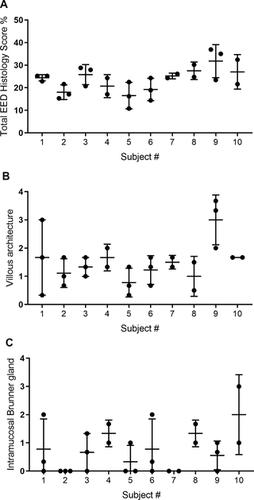当前位置:
X-MOL 学术
›
PLOS Negl. Trop. Dis.
›
论文详情
Our official English website, www.x-mol.net, welcomes your
feedback! (Note: you will need to create a separate account there.)
A novel histological index for evaluation of environmental enteric dysfunction identifies geographic-specific features of enteropathy among children with suboptimal growth.
PLOS Neglected Tropical Diseases ( IF 3.4 ) Pub Date : 2020-01-13 , DOI: 10.1371/journal.pntd.0007975 Ta-Chiang Liu 1 , Kelley VanBuskirk 2 , Syed A Ali 3 , M Paul Kelly 4, 5 , Lori R Holtz 2 , Omer H Yilmaz 6 , Kamran Sadiq 3 , Najeeha Iqbal 3 , Beatrice Amadi 4 , Sana Syed 3, 7 , Tahmeed Ahmed 8, 9 , Sean Moore 7 , I Malick Ndao 2 , Michael H Isaacs 1 , John D Pfeifer 1 , Hannah Atlas 10 , Phillip I Tarr 2 , Donna M Denno 10 , Christopher A Moskaluk 11
PLOS Neglected Tropical Diseases ( IF 3.4 ) Pub Date : 2020-01-13 , DOI: 10.1371/journal.pntd.0007975 Ta-Chiang Liu 1 , Kelley VanBuskirk 2 , Syed A Ali 3 , M Paul Kelly 4, 5 , Lori R Holtz 2 , Omer H Yilmaz 6 , Kamran Sadiq 3 , Najeeha Iqbal 3 , Beatrice Amadi 4 , Sana Syed 3, 7 , Tahmeed Ahmed 8, 9 , Sean Moore 7 , I Malick Ndao 2 , Michael H Isaacs 1 , John D Pfeifer 1 , Hannah Atlas 10 , Phillip I Tarr 2 , Donna M Denno 10 , Christopher A Moskaluk 11
Affiliation

|
BACKGROUND
A major limitation to understanding the etiopathogenesis of environmental enteric dysfunction (EED) is the lack of a comprehensive, reproducible histologic framework for characterizing the small bowel lesions. We hypothesized that the development of such a system will identify unique histology features for EED, and that some features might correlate with clinical severity.
METHODS
Duodenal endoscopic biopsies from two cohorts where EED is prevalent (Pakistan, Zambia) and North American children with and without gluten sensitive enteropathy (GSE) were processed for routine hematoxylin & eosin (H&E) staining, and scanned to produce whole slide images (WSIs) which we shared among study pathologists via a secure web browser-based platform. A semi-quantitative scoring index composed of 11 parameters encompassing tissue injury and response patterns commonly observed in routine clinical practice was constructed by three gastrointestinal pathologists, with input from EED experts. The pathologists then read the WSIs using the EED histology index, and inter-observer reliability was assessed. The histology index was further used to identify within- and between-child variations as well as features common across and unique to each cohort, and those that correlated with host phenotype.
RESULTS
Eight of the 11 histologic scoring parameters showed useful degrees of variation. The overall concordance across all parameters was 96% weighted agreement, kappa 0.70, and Gwet's AC 0.93. Zambian and Pakistani tissues shared some histologic features with GSE, but most features were distinct, particularly abundance of intraepithelial lymphocytes in the Pakistani cohort, and marked villous destruction and loss of secretory cell lineages in the Zambian cohort.
CONCLUSIONS
We propose the first EED histology index for interpreting duodenal biopsies. This index should be useful in future clinical and translational studies of this widespread, poorly understood, and highly consequential disorder, which might be caused by multiple contributing processes, in different regions of the world.
中文翻译:

一种用于评估环境肠道功能障碍的新组织学指标确定了生长不良儿童中肠病的地理特异性特征。
背景 了解环境肠功能障碍 (EED) 的发病机制的一个主要限制是缺乏用于表征小肠病变的全面、可重复的组织学框架。我们假设这种系统的开发将识别 EED 的独特组织学特征,并且某些特征可能与临床严重程度相关。方法 对 EED 流行的两个队列(巴基斯坦、赞比亚)和北美有和无麸质敏感性肠病(GSE)儿童的十二指肠内镜活检进行常规苏木精和伊红(H&E)染色,并扫描以产生整个幻灯片图像(WSI ) 我们通过基于网络浏览器的安全平台在研究病理学家之间共享。由 11 个参数组成的半定量评分指数,包括常规临床实践中常见的组织损伤和反应模式,由三位胃肠病理学家在 EED 专家的投入下构建。然后病理学家使用 EED 组织学指数读取 WSI,并评估观察者间的可靠性。组织学指数进一步用于识别儿童内部和儿童之间的变异以及每个队列共有和独特的特征,以及与宿主表型相关的特征。结果 11 个组织学评分参数中有 8 个显示出有用的变异程度。所有参数的总体一致性为 96% 加权一致性、kappa 0.70 和 Gwet 的 AC 0.93。赞比亚和巴基斯坦组织与 GSE 有一些共同的组织学特征,但大多数特征是不同的,在巴基斯坦队列中特别丰富的上皮内淋巴细胞,在赞比亚队列中明显的绒毛破坏和分泌细胞谱系的丧失。结论 我们提出了第一个用于解释十二指肠活检的 EED 组织学指数。该指数在未来对这种广泛存在的、知之甚少且后果严重的疾病的临床和转化研究中很有用,这可能是由世界不同地区的多种贡献过程引起的。
更新日期:2020-01-14
中文翻译:

一种用于评估环境肠道功能障碍的新组织学指标确定了生长不良儿童中肠病的地理特异性特征。
背景 了解环境肠功能障碍 (EED) 的发病机制的一个主要限制是缺乏用于表征小肠病变的全面、可重复的组织学框架。我们假设这种系统的开发将识别 EED 的独特组织学特征,并且某些特征可能与临床严重程度相关。方法 对 EED 流行的两个队列(巴基斯坦、赞比亚)和北美有和无麸质敏感性肠病(GSE)儿童的十二指肠内镜活检进行常规苏木精和伊红(H&E)染色,并扫描以产生整个幻灯片图像(WSI ) 我们通过基于网络浏览器的安全平台在研究病理学家之间共享。由 11 个参数组成的半定量评分指数,包括常规临床实践中常见的组织损伤和反应模式,由三位胃肠病理学家在 EED 专家的投入下构建。然后病理学家使用 EED 组织学指数读取 WSI,并评估观察者间的可靠性。组织学指数进一步用于识别儿童内部和儿童之间的变异以及每个队列共有和独特的特征,以及与宿主表型相关的特征。结果 11 个组织学评分参数中有 8 个显示出有用的变异程度。所有参数的总体一致性为 96% 加权一致性、kappa 0.70 和 Gwet 的 AC 0.93。赞比亚和巴基斯坦组织与 GSE 有一些共同的组织学特征,但大多数特征是不同的,在巴基斯坦队列中特别丰富的上皮内淋巴细胞,在赞比亚队列中明显的绒毛破坏和分泌细胞谱系的丧失。结论 我们提出了第一个用于解释十二指肠活检的 EED 组织学指数。该指数在未来对这种广泛存在的、知之甚少且后果严重的疾病的临床和转化研究中很有用,这可能是由世界不同地区的多种贡献过程引起的。










































 京公网安备 11010802027423号
京公网安备 11010802027423号